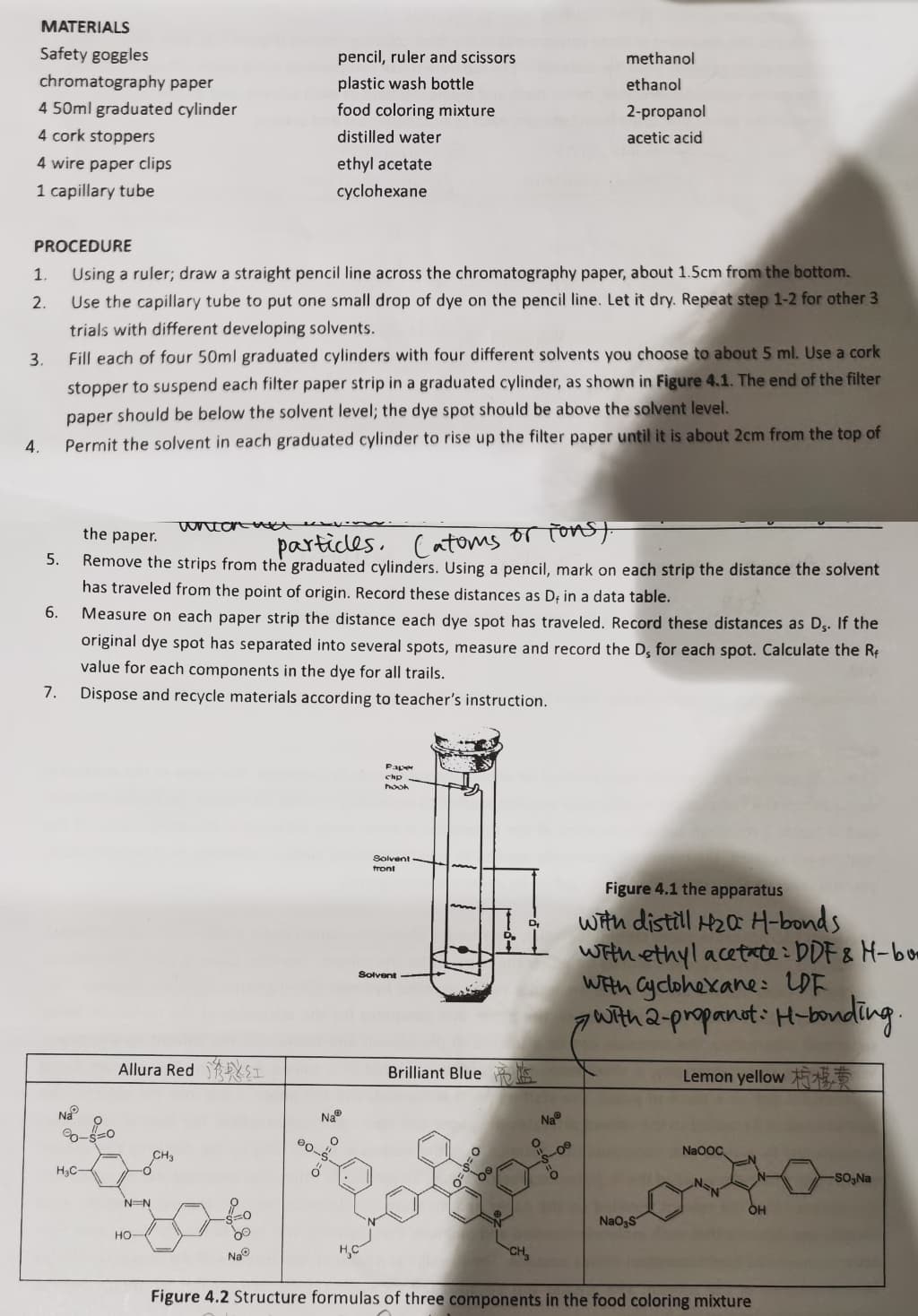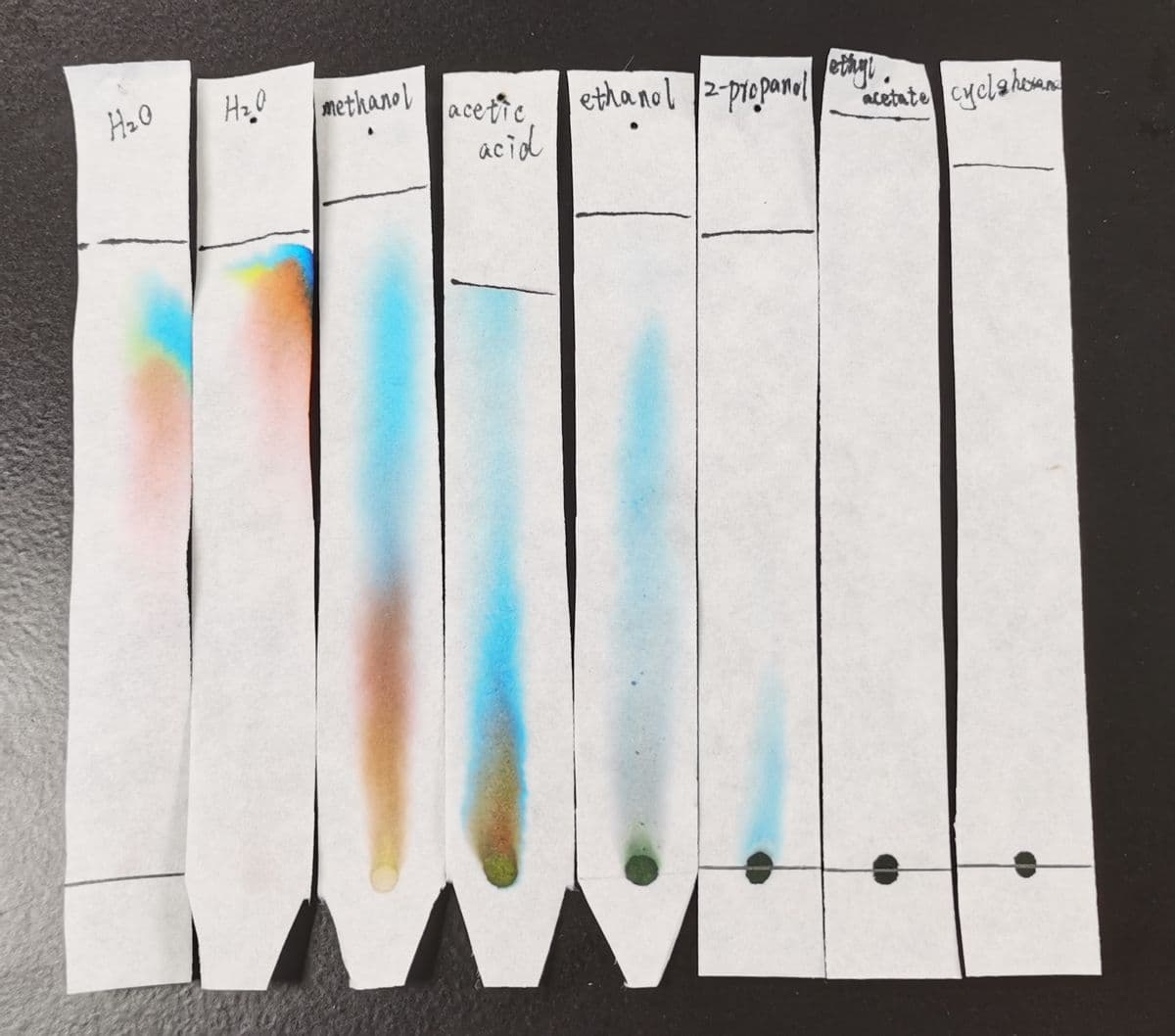Chapter11: Properties Of Solutions
Section: Chapter Questions
Problem 109AE: Patients undergoing an upper gastrointestinal tract laboratory test are typically given an X-ray...
Related questions
Question
which color component runs the fastest in the best trial? explain this in terms of intermolecular forces to the best of your knowledge

Transcribed Image Text:MATERIALS
Safety goggles
pencil, ruler and scissors
methanol
chromatography paper
plastic wash bottle
ethanol
4 50ml graduated cylinder
food coloring mixture
2-propanol
4 cork stoppers
distilled water
acetic acid
4 wire paper clips
ethyl acetate
1 capillary tube
cyclohexane
PROCEDURE
1.
Using a ruler; draw a straight pencil line across the chromatography paper, about 1.5cm from the bottom.
2.
Use the capillary tube to put one small drop of dye on the pencil line. Let it dry. Repeat step 1-2 for other 3
trials with different developing solvents.
3.
Fill each of four 50ml graduated cylinders with four different solvents you choose to about 5 ml. Use a cork
stopper to suspend each filter paper strip in a graduated cylinder, as shown in Figure 4.1. The end of the filter
paper should be below the solvent level; the dye spot should be above the solvent level.
Permit the solvent in each graduated cylinder to rise up the filter paper until it is about 2cm from the top of
4.
partices, (atoms or Tonst
Remove the strips from the graduated cylinders. Using a pencil, mark on each strip the distance the solvent
uncan u
the paper.
5.
has traveled from the point of origin. Record these distances as D; in a data table.
6.
Measure on each paper strip the distance each dye spot has traveled. Record these distances as Dş. If the
original dye spot has separated into several spots, measure and record the D, for each spot. Calculate the Rf
value for each components in the dye for all trails.
7.
Dispose and recycle materials according to teacher's instruction.
Paper
chp
hooh
Solvent
front
Figure 4.1 the apparatus
with distill H2Q H-bonds
With ethyl acetate: DDF & H-bm
WEth Cyclohexane: LDF
gwith 2-propanut: H-bonding.
Solvent
Allura Red YSI
Brilliant Blue o
Lemon yellow
Na
Na®
Na
Na0oC.
CH3
H3C-
SO,Na
N=N
ÓH
NaogS
но-
Na
H,C
Figure 4.2 Structure formulas of three components in the food coloring mixture

Transcribed Image Text:metkanol
ethanol 2-prepanol
acetic
acid
acetate Cyclahoand
Expert Solution
This question has been solved!
Explore an expertly crafted, step-by-step solution for a thorough understanding of key concepts.
This is a popular solution!
Trending now
This is a popular solution!
Step by step
Solved in 3 steps with 1 images

Knowledge Booster
Learn more about
Need a deep-dive on the concept behind this application? Look no further. Learn more about this topic, chemistry and related others by exploring similar questions and additional content below.Recommended textbooks for you


Chemistry
Chemistry
ISBN:
9781305957404
Author:
Steven S. Zumdahl, Susan A. Zumdahl, Donald J. DeCoste
Publisher:
Cengage Learning

Chemistry: An Atoms First Approach
Chemistry
ISBN:
9781305079243
Author:
Steven S. Zumdahl, Susan A. Zumdahl
Publisher:
Cengage Learning


Chemistry
Chemistry
ISBN:
9781305957404
Author:
Steven S. Zumdahl, Susan A. Zumdahl, Donald J. DeCoste
Publisher:
Cengage Learning

Chemistry: An Atoms First Approach
Chemistry
ISBN:
9781305079243
Author:
Steven S. Zumdahl, Susan A. Zumdahl
Publisher:
Cengage Learning



EBK A SMALL SCALE APPROACH TO ORGANIC L
Chemistry
ISBN:
9781305446021
Author:
Lampman
Publisher:
CENGAGE LEARNING - CONSIGNMENT